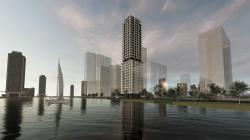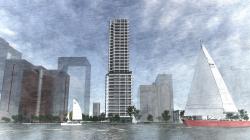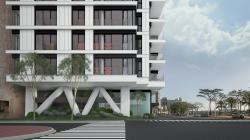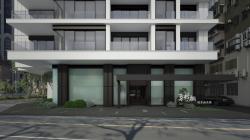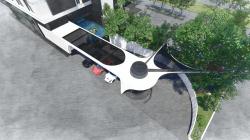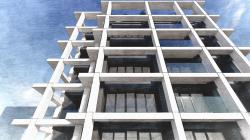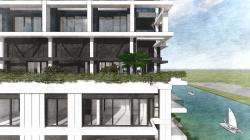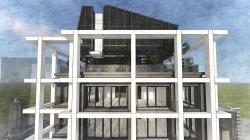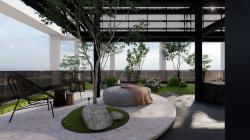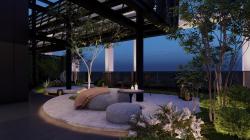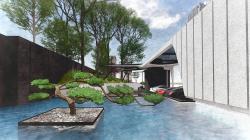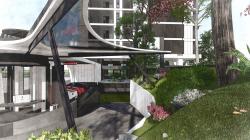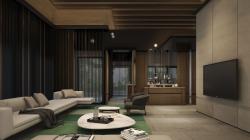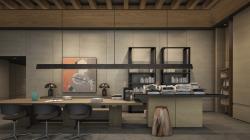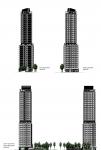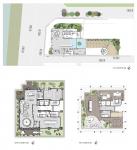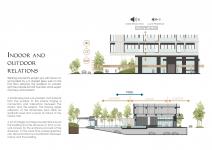kyscrapers are structures that are associated with any city. They are tall, often without function and try to make the best use of the space they are constructed on. The property is located on the banks of the Love River, overlooking the mountains and rivers of the port of Kaohsiung. Once constructed, it will be 29 floors high and will allow its residents to have a fantastic view of the city and the river.
There were two significant challenges: the first being the size of the property and the second being the rules governing skyscrapers in Taiwan. Secondly Taiwan is in an earthquake zone meaning rules for construction are stricter than in other countries. Hope to create upscale apartments for people who are willing to pay a premium for an impressive location, environmental features and a greater integration with the natural environment.
The building is primarily white and this layer continues from the base to the outer frame of the high-rise floor. The white layer contrasts with the low-reflective black aluminum metal plate. When light hits the framework at different times, light and shadow appear differently in each space. At the same time, it expresses people's demand for a habitat in the natural environment and highlights the concept of habitat protection for all things.
In any habitat, you have to have greenery, foliage and shrubbery and Habitat 29 tried to be as green as possible. A large amount of greenery exists on the relay and roof layer of the building. This is integrated into the green roof irrigation system, enabling the green space to achieve energy-saving benefits through its system and plant greenery. Its energy-saving value U is 0.38, which reduces radiant heat conduction. Plants and greenery make the building conforms to nature and integrates into the entire Kaohsiung harbor.
Walking around the project you will notice it is surrounded by the U-shaped glass wall on the first floor allowing the residents to connect with the outside but still maintain some aspect of privacy and isolation. This wall reduces both visual and auditory noise. A large window is on the right side of the reception and opposite the entrance. A landscape pool was created, that extends from the outdoor to the interior forging a connection and interaction between the interior and the exterior. A lot of foliage and trees are planted around the building and the driveway to form a natural canopy for the entrance and exit of the driveway. At the same time, proper greenery can also promote the coordination between nature and the building.
The architect wanted to create a vibrant simplistic space incorporating nature to create an environment that people want to come home to in this fast paced and often stressful world. A place that can take you away while being aesthetically pleasing to all who come upon it. It is hoped that other skyscrapers and architects will take notice when they are creating sustainable living for the future.
2020
2021
Living in Taiwan, the summer heat lasts for approximately 9 months out of the year. Any new building in order to be environmentally friendly and energy efficient needs solutions to address keeping the residents and building cool.
The facade uses energy-saving panels and Stö paint to prevent heat conduction. 32mm-thick Low-E glass was used for the exterior of the building, with a heat transfer coefficient U of 1.19. In summer, heat radiation such as ultraviolet and near-infrared rays of the sun can be blocked from entering the room. In winter, glass can reflect most of the radiation back indoors to ensure that indoor heat is not lost to the outdoors while maintaining sufficient brightness. The withdrawal of the building allows for a balcony, which can reduce direct sunlight exposure to the room and reduce the rate of air conditioning consumption.
The structure is also incapsulated in what looks like a framework. While appearing arbitrary, it serves the purpose of creating shadows and reflections for the residents. This may seem unimportant but these minor details help the inhabitants keep track of the passage of time while they are indoors.
Ken Lo
Habitat 29 by Keng-Fu Lo in Taiwan won the WA Award Cycle 37. Please find below the WA Award poster for this project.
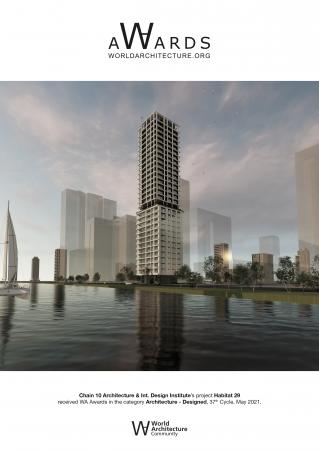
Downloaded 10 times.
Favorited 3 times


